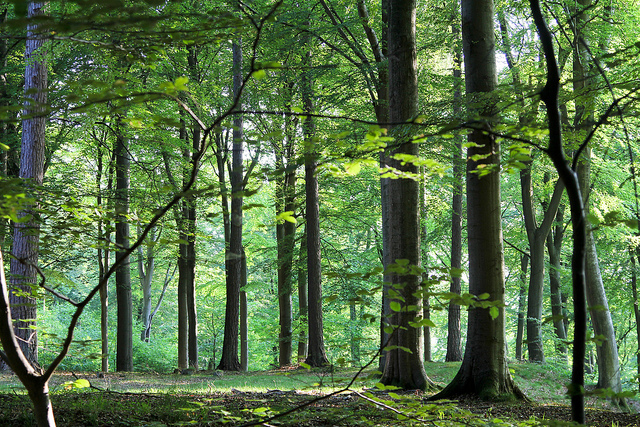Trees of Denmark Posted by Bjørn A. Bojesen on May 16, 2018 in Vocabulary
Bøgen er sprunget ud! (The beech has come into leaf!) It’s always a great begivenhed (happening) when Denmark’s national tree gets its first blade (leaves) after the long, leafless vinter season. Skove (forests) all across the realm turn breathtakingly lysegrøn (light green), hvide anemoner (white anemones) bloom between the rødder (roots – rod in the singular) and all kinds of people flock to the forests to walk – or mountain-bike (!) – among the høje stammer (tall trunks) like it’s a temple or something. And true enough, when forårssolen (the Spring sun) is gleaming between the lysegrønne kroner (light green [tree] crowns), I do think it’s something of the smukkeste (most beautiful) the country’s got to offer. 🙂 Let’s take a look at the real ”mountains” of Denmark – its træer (trees):
Please note that most tree names in Danish come with/without the -træ (-tree) suffix! So, it technically doesn’t matter whether you say bøg (beech) or bøgetræ (”beech-tree”). The names without the suffix tend to be a bit more poetic or formal, though, but there isn’t a fixed rule on this. Also note that 99% of the ”bare” names take the (-)en article – bøgen vs bøgetræet; granen vs grantræet.
- nåletræerne (the ”needle trees” = conifers) of course are green året rundt (all the year round). You’ve got gran(træ) (spruce) and fyr(retræ) (pine). Gran/er are grown in plantations to be sold as juletræer (Xmas trees!) Oh, I forgot, there’s an exception… The tree known as lærk(etræ) (larch) actually does lose its nåle (”needles”) om efteråret (in Autumn/Fall).
- an eg(etræ) [eyy] (oak) can become very old and look like something straight out of a fantasy movie! 🙂 Check out the jagged leaves.
- think of a zebra, and you easily spot a birk(etræ) (birch) – the only major Scandi tree with areas of white bark. They’re more common in Sweden than in DK, though.
- a pil(etræ) (willow) often has all its grene (branches) and kviste (twigs) hanging down, as if it’s crying. Funnily, the word pil also means ”arrow”. 🙂
- frugttræer (fruit trees) always take the -træ suffix (otherwise you just end up with the name of the tree!) Common ones in DK include æbletræ, pæretræ, blommetræ and kirsebærtræ (apple, pear, plum, cherry tree).
- other common Danish trees are ask, ahorn [Ah-horn], lind [lenn], poppel, el, elm and røn (with red bær, berries!) I don’t know how well-known they are in the English-speaking world, but the names mean ash, maple, lime, poplar, alder, elm and rowan. As you can probably see, Danish and English are related languages. 😉

Build vocabulary, practice pronunciation, and more with Transparent Language Online. Available anytime, anywhere, on any device.






Comments:
Rafael:
How can I say pine or pinetree in danish?
Bjørn A. Bojesen:
@Rafael @Rafael – thanks for the question and sorry for the late reply… Pine in Danish is fyr or fyrretræ. I see that I’ve kind of mis-translated the word, so I’ll correct… (A fir is actually a kind of spruce in English, right?)
Rafael:
@Bjørn A. Bojesen Mange tak, Bjørn!
Bjørn A. Bojesen:
@Matthew. Yes, indeed. 🙂 Hope you do!